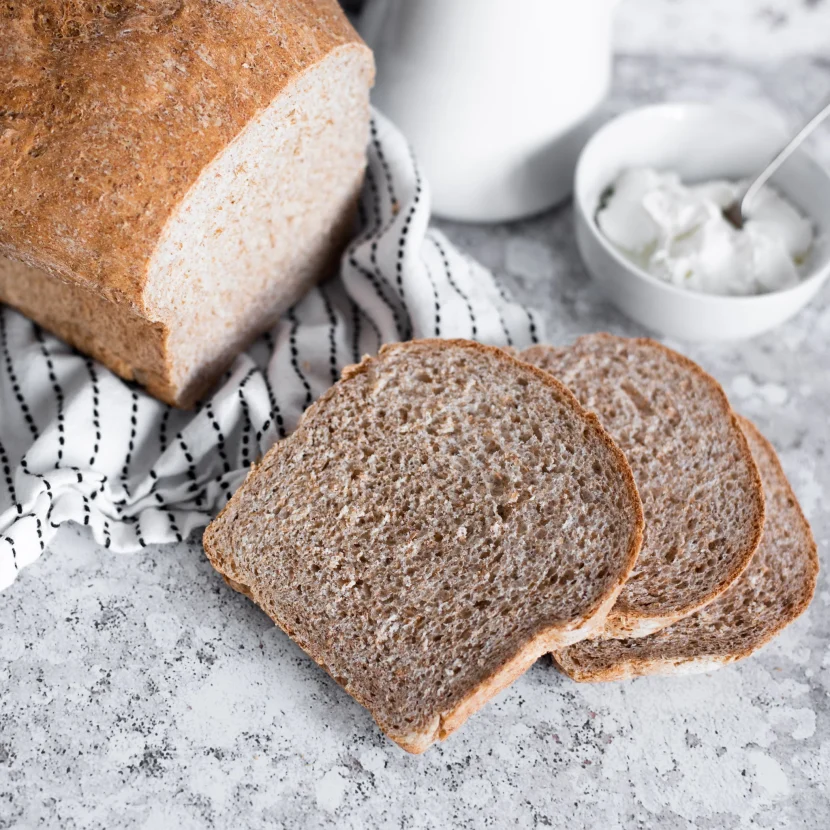I used to think that making bread was something that only professional bread-makers could do. It wasn’t until I decided one day to attempt making my own bread (because I was sick of shop bought bread plastic packaging with lots of preservatives), that I discovered it didn’t take a genius to make a half decent loaf! Now, I have made over 5 loaves of bread and have managed to achieve consistent quality of my homemade loaves. I wanted to share with you the recipe and techniques I use to make a perfect homemade 50/50 loaf of bread.
To prevent waste, I keep my sliced bread in the freezer and just use the ‘defrost’ setting on my toaster to make them like new again if I want to make a sandwich or toast. Since making my own bread, I have not had any bread food waste. I think it really does help to keep bread in the freezer (even shop bought bread) to prevent food waste. There is so much food waste (approx. 1/3 of all food bought is wasted, when it could be put to good use), so making use of your freezer will help you to waste less food and save money in the process (more food in tummies, less in the bin = less shopping trips to buy more food).
Note: This recipe is a 50/50 of wholemeal spelt and white spelt flours; but I am looking to try out a wholemeal spelt and soya flour loaf in the near future, so stay tuned for that.
key facts:
- Yield: 18 slices of bread
- Cost: 86p per loaf, 5p per slice
- Total Time: 2 hours 50 mins (Prep: 20 mins, Prove: 2 hours, Cook: 30 mins)
- Difficulty: Easy
- Suitability: Vegetarian, Vegan, Dairy-Free (for gluten free, use gluten free flours available from most supermarkets)
equipment:
- Large Bowl/Pan
- Scales
- Jug (preferably microwaveable)
- Fork
- Tablespoon
- Teaspoon
- Loaf Tin (for 500g loaf – mine is 8.5” x 4.5”)
- Something to cover loaf while proving – a towel or muslin cloth (I use a Kilner Muslin Cloth)
- Oven Gloves
- Bread Knife
ingredients (cost 5p per slice)
‘Wet’ Ingredients:
- 300ml Water (Hand hot) – you may only need to use 250ml, but it is nice to have some spare just in case
- 2 heaped teaspoons (7g) Dried Active Yeast – approx. 7p (I use Allinson Easy Bake Yeast) – approx. (98p for 100g from Asda)
- 1 tablespoon (15ml) Natural Sweetener (I use Agave Nectar, you may also use Maple Syrup, but I find this more expensive) – approx. 15p (£2.50 for 250ml from Tesco)
- 1 tablespoon (15ml) Vegetable Oil (I use Rapeseed Oil. Most ‘Vegetable Oil’ is rapeseed oil, just check the ingredients on the back) – approx. 2p (£1.09 for 1L from Asda/Aldi/Lidl)
- Dry Ingredients:
- 250g Organic Wholewheat Spelt Flour – approx. 31p (£1.25 for 1Kg from Aldi)
- 250g Organic White Spelt Flour – approx. 31p (£1.25 for 1Kg from Aldi)
- Optional: 1 level teaspoon grounded Sea Salt (to taste, can be omitted, not included in cost calculation)
- Optional: Add your favourite Seeds (not included in the cost calculation) – for example, chia seeds, flaxseed, poppy seeds, sunflower seeds, pumpkin seeds, or maybe even some rolled oats. I would recommend adding up to 5 tablespoons of your choice of seeds. Add a variety to achieve an interesting loaf full of flavour and added fibre. I always add organic chia seeds and organic poppy seeds (1 tablespoon of each) to my mine for added protein and for a little crunch to the loaf.
method:
- Add 300ml of Water to a jug. Put in the microwave (if microwaveable) for 1-2 minutes, checking at 15 second intervals to see if hand hot. Alternatively, add 200ml boiling hot water from a kettle to 100ml cold water (apparently using a microwave uses less energy than other heating devices – thank you to students saving the planet with their microwave food obsession).
- Add the Active Dried Yeast to the water and stir well with a fork. Add the Natural Sweetener and Vegetable Oil, then stir again. Leave for 15 minutes.
- Meanwhile, add the Flours, any Seeds and Salt to a large mixing bowl or pan (I use pans for stability and as I don’t own a mixing bowl). Stir well using a fork.
- After the 15 minutes has elapsed, add (almost all) of the yeast water to the bowl/pan of flour. Use the fork to mix well. When you feel the fork is no longer helpful in mixing, use one or both of your (clean dry) hands to form a dough. This will take around 5 minutes. Add the remaining water if you feel the dough is too dry and add a little flour (25g at a time) if you feel the dough is sticky (as some remains on your fingers when you remove your hands from the dough). Tip: Before adding any water or flour, make sure you have mixed the dough for a few minutes, as it might turn out that no more water and flour is needed.
- When the dough is to the right consistency, knead the dough for 5 minutes. This doesn’t need to be on a floured surface and create more mess, I just do this within the large metal pan I use as this keeps everything tidy. You don’t need to feel intimidated as I don’t use any specific techniques. I usually just bash the dough around for 5 minutes, rip, roll, throw into the pan. I basically use the dough as a stress ball and take out any stresses that I have had during the week on it (funnily enough I do this on a ‘peaceful’ Sunday as it is the day when I have the most free time to make things).
- Then I make the dough into a nice ball within the centre of the pan and cover with cotton muslin (instead of plastic cling film as I am trying to reduce my plastic usage). Leave for 45 minutes to an hour (until it has doubled) to prove. Tip: Keeping it in a warm location can help speed up this process, but I have found it is not necessary.
- After the time has elapsed or the dough has doubled, put the cotton muslin to one side. ‘Knead’ the dough for a further 5 minutes, this time concentrating on punching the dough whilst in the pan to remove any air bubbles. Make sure you use the dough as a stress ball, with some throwing into the pan, stretching and rolling like before. This may sound odd, but the more I concentrate on the dough being a stress ball and less like a process of ‘professional step by step kneading’, the more fun I have had (relieving some stress) and the better the loaf has turned out.
- Grease a loaf tin with a teaspoon of oil. You can use your finger (I find this easier and quicker) or use a tissue to spread. I find using tissue not necessary; practically, economically and environmentally – since trees need to be cut down for us to make tissue, as it doesn’t grow from trees unfortunately.
- In the air, use both hands to make the dough into roughly a shape that fits your loaf tin (mine is a rectangle).
- Then place the dough into your loaf tin and spread the dough evenly, ensuring it is flush on the surface, including the edges.
- Cover with the cotton muslin again. Leave for a further 45 minutes to an hour (until it has doubled) to prove again. You can repeat this step a further time, but I am impatient, so I don’t. ?
- When you notice the dough has doubled (don’t take off the cotton muslin), immediately put the oven on 200*C/Gas 6/Fan 180*C. When the oven is preheated, immediately add the loaf into the oven (without the muslin) using oven gloves. Leave to bake for 20-30 minutes. Keep an eye on it after 20 minutes has elapsed, at 5 minute intervals. When the loaf is ready it will sound hollow when you ‘knock it’ (like you would knock on someones door).
- When ready, turn off the oven and remove the loaf tin with oven gloves.
- Turn the loaf out onto a cooling wrack (the oil from when you lined the tin should help it to come out easily) or a clean wooden chopping board (I use a bamboo chopping board). If using a wooden chopping board, just move the bread to a dry area of the chopping board every 5 minutes or so, until the loaf has cooled down (the wood is able to absorb the moisture of the loaf).
- When the loaf has cooled, use a bread knife to cut slices of bread approximately 1-2cm thick (depending on your preference). Generally the thicker the slice, the easier it is to slice the bread.
- Now you can eat some and save the rest in the freezer (this keeps it fresh). I could tell you to eat it within a month, but I guarantee you would have eaten it within a week, if not a few days (if your like me).
I am really proud of this recipe, so I hope this works for you. I have even had it tested by my Nan, with positive feedback. Have you tried this recipe or tried to make your own bread before? I would love to hear your experiences in the comments below.
You are the best thing since sliced bread..
Originally published on: 11/7/2018




